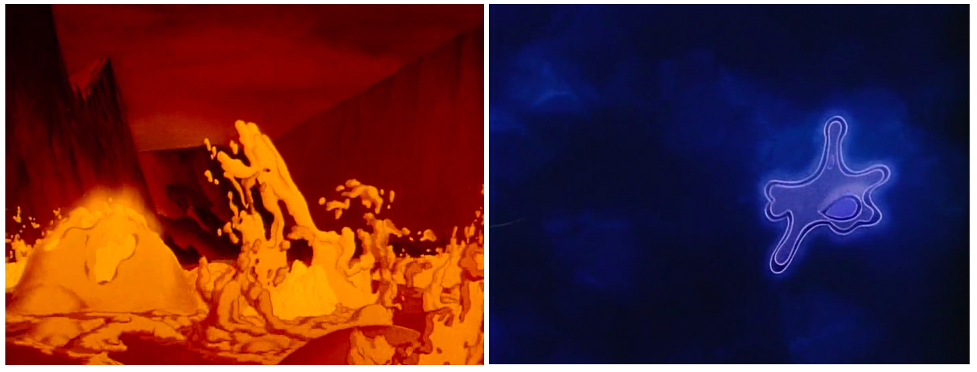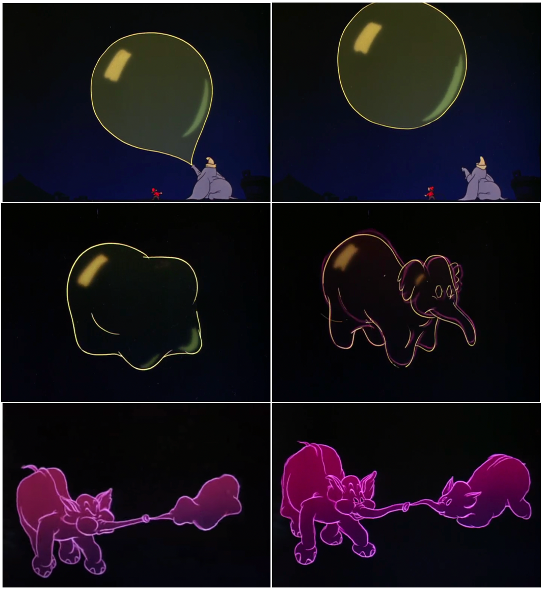In 1955, Walt Disney Productions released A World Is Born, a 16mm short animated educational science film that visualized the natural history of Earth from the origins of cellular life to the extinction of the dinosaurs (see Figure 1). The film repurposed the popular “Rite of Spring” segment from Disney’s experimental animated musical Fantasia (1940) and added a voiceover narration track that offered straightforward biology lessons designed for classroom use. At one point, as microorganisms squiggle around inside the frame, the narrator explains that the living cells are “so tiny, we look at them here through a microscope.” The language was drawn directly from the natural history film genre, which had been popularizing scientific knowledge of nature for decades. But, of course, we are not looking through a microscope. These are cel animations of the earliest living cells on Earth that emerged in a process called abiogenesis—the original spontaneous generation of life from nonliving matter. And, unlike microorganisms teeming in natural history films, these origins of life cannot be documented, say, with microcinematography.

While A World Is Born is an interesting afterlife of “Right of Spring,” here I want to treat the documentary impulse that cuts across both animations as an opportunity to rethink what is an otherwise well-traveled film in animation studies, or rather to refocus one of Fantasia’s more curious aspects. In an address given to the New York Academy of Sciences in late 1940, the American paleontologist Barnum Brown reportedly remarked of Fantasia, “Mickey Mouse had to be created so we could see the creation of the world.”[i] The remark was not hyperbole. Brown was one of several expert advisors who collaborated with Disney animators to ensure that the phenomena being animated in “Rite of Spring” most accurately reflected scientific knowledge at the time. The goal was to create an animated documentary about the origins and evolution of life, but, as the studio explained, “no one knows what actually happened when the world was created.”[ii] With its potential for visualizing the inaccessible—what Mihaela Mihailova (2019) calls “animation’s penetrative gaze”—animation seemed tailor-made to bring those aspects of natural history to life.

What makes “Rite of Spring” so remarkable is that natural history was used to showcase highly innovative “effects animation” techniques that the Walt Disney Studio was developing at the time. For example, the segment opens with a long camera movement through a swirling galaxy created by filming stars and cosmic gasses that were painted on glass plates and rotated in an elaborate multiplane camera device (Figure 2). For sequences depicting volcanic eruptions that fueled the emergence of cellular life, animators and effects engineers worked with a novel wash-off relief process that transferred photographic motion studies of paint being dripped into water tanks, fire, bubbles, and microorganisms directly onto cels that animators could manipulate. These techniques allowed the studio to imbue the un-documentable events of early natural history with the spontaneity and contingency of movements and transformations taken directly from the natural world.
At a time when the studio was using these effects techniques to chart a new realist future for animation, it is curious that Walt Disney looked back and animated the origins and early history of life. In “Rite of Spring,” primordial scenes of churning and bubbling lava and frenzied microorganisms point strongly to that mesmerizing characteristic of Disney’s animated cartoons that Sergei Eisenstein (2017: 32) likened to “the primal protoplasm”: the plasmatic-ness of drawn cartoons that was gradually eclipsed by the pursuit of animated realism (Figure 3). Indeed, the protoplasm that Eisenstein invoked to describe the amoeboid squashing and stretching of earlier animations was the same albuminous substance that made it possible for abiogenesis to occur. By animating the origins of life—literally a scene of animation, of inanimate matter coming to life—Disney seems (most likely unintentionally) to return us to something primordial: animation’s potential for generating spontaneous movements, metamorphoses, and life.

In this regard, “Rite of Spring” has something quite unexpected in common (beyond resemblance) with the natural history films that it emulated. Films documenting biological phenomena—e.g., the lives of plants, insects, and microbes—have long played important roles in efforts to theorize the unique possibilities of film. As Caroline Hovanec (2019: 246) explains, for everyone from Jean Epstein and Germaine Dulac to Walter Benjamin and Siegfried Kracauer, the strange spectacles of plants growing and amoebae transforming in natural history films “embod[ied] the promise of cinema as a medium” because they demonstrated the potential of devices like magnification, slow-motion, and time-lapse to reveal unseen aspects of life and movement. Given that “Rite of Spring” drew on similar spectacles to demonstrate the potential of novel effects techniques to imbue animations with spontaneity and contingency, the segment seems to invite us to see biological phenomena as being likewise uniquely suited to animation.
A World Is Born is the obvious outcome of this affinity—the explicit union of animation and natural history in documentary form—but if we probe the affinity more deeply, familiar films like Fantasia open up onto new terrain. For example, we might begin to see the theme of abiogenesis echoed in Fantasia’s other sequences depicting fairies that bring plants to life, ghosts and demons that are reanimated in fire, and abstract formations of color that dance and morph like the primordial forms of natural history. We might also begin to see the subtle way that the biology in “Rite of Spring” seems to have informed other animations like the “Pink Elephants on Parade” sequence in Dumbo (1941), in which the titular character, intoxicated, blows bubbles that transform like amoebae into plasmatic elephants, which in turn autogenerate like cells dividing under a microscope (Figure 4).

These connections are all the more interesting when we consider that those key terms—e.g., life, movement, metamorphosis—which drive much of animation and animation studies are also the proper domains of biology and natural history, domains that are, Fantasia suggests, as suited to animation as fantasy and visual music.
[i] Quoted in “Leading Scientists Help Create Scenes for Disney Picture.” ND, pg. 2. Fantasia Files, Walt Disney Archives. I have not yet tracked down Brown’s original address, but it was most likely given at the Academy’s Annual Dinner and Meeting on December 11, 1940.
[ii] “Disney Personnel Conducted Vast Research to Unearth Dinosaur Skin Texture.” ND, pg. 1. Fantasia Files, Walt Disney Archives.
References
Eisenstein, Sergei (2017) On Disney. Jay Leyda (ed) and Alan Upchurch (trans). London: Seagull Books.
Hovanec, Caroline (2019) Another Nature Speaks to the Camera: Natural History and Film Theory. Modernism/modernity 26 (2): 243-265.
Mihailova, Mihaela (2019) Before Sound, there was Soul: The Role of Animation in Silent Nonfiction Cinema. In: Jonathan Murray and Nea Ehrlich (eds) Drawn from Life: Issues and Themes in Animated Documentary Cinema. Edinburgh: Edinburgh University Press, pp. 31-46.
Colin Williamson is Assistant Professor of cinema studies and American studies at Rutgers University. He also serves on the Executive Committee of Domitor, the International Society for the Study of Early Cinema, and as Reviews Editor for animation: an interdisciplinary journal. He is the author of Hidden in Plain Sight: An Archaeology of Magic and the Cinema (Rutgers University Press, 2015) and has published articles and essays in such edited collections and journals as Thinking in the Dark: Cinema, Theory, Practice (Rutgers University Press, 2016), Leonardo, The Moving Image, Imaginations, and Film History. His research has been supported by fellowships and awards from the American Academy of Arts and Sciences, Harvard University, Rutgers University, and the University of Pennsylvania.

3 comments for “On Biology and Natural History in “Fantasia” (1940)”